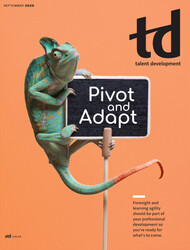TD Magazine Article
Find Your On-Camera Confidence
For virtual training, when you’re live on camera, things can sometimes feel uncomfortable, and your anxiety can skyrocket. These tips can help you effectively deliver training on camera.
Tue Sep 01 2020

THE SITUATION
Lights, cameras, awkward? Face-to-face classroom instruction is the ultimate comfort zone for most talent development professionals. But for virtual training, when you're live on camera, things can sometimes feel uncomfortable, and your anxiety can skyrocket. Because picturing the audience with funny hats on doesn't quite work with online training, what tips can help you effectively deliver training on camera?
THE TRICK
Setting the atmosphere for a successful virtual training experience depends greatly on your ability to create a safe, comfortable environment that is conducive to learning. Feeling less than confident does not aid in that endeavor. In fact, your uneasiness can distract learners. Here are ways you can trade on-camera awkwardness and uneasiness for confidence and comfort.
Take pride in your personal appearance. Groom or glam yourself as you would if you were presenting in person. If you would fix your hair a certain way or wear a particular outfit, do the same for your online courses. Experts say there's a direct correlation between grooming and clothing and how you think, feel, and behave.
Complete your preparation rituals. If you'd normally practice in front of a mirror or record yourself ahead of a face-to-face learning experience, do the same for your virtual courses. The more you practice, the more comfortable you become.
Lead from a lectern. A standing desk or lectern to present from may seem like a weird prop for online training, but it can help you come across just as confident as you would in person. Often, this puts facilitators in presentation mode, which brings an element of familiarity to what may be an unfamiliar way of training.
Cap your camera time. For virtual training sessions, it's acceptable to go on camera just for introductions and break announcements as well as to conclude the session. Not only does that reduce your on-camera time, but it also enables learners to better focus on the presented content.
Deliver training from a distraction-free environment. Everything from a cluttered, unprofessional background to unexpected interruptions from pets and loved ones count as distractions. Knowing that you have a clutter-free background and that you're not subject to distractions will help elevate your virtual presence and enable you to devote your total concentration to the course.
PRO TIP
Poor internet or network connections can result in echoing audio, a frozen screen, and other unfavorable issues. As you can imagine, dealing with such issues in the middle of a training session can shatter even the most seasoned facilitator's confidence while decreasing the value of learners' entire experience. A reliable, fast internet connection is the bedrock of a successful virtual training experience.

